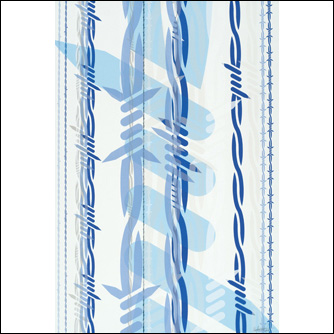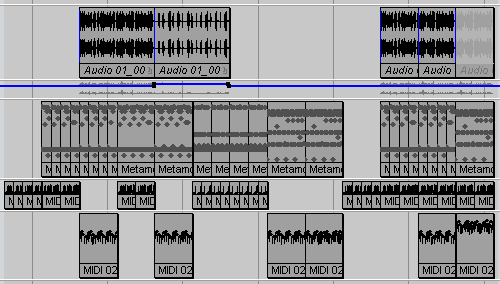View current page
...more recent posts
More VVork.
Sally McKay's comment about the blog's specialty--"elegant sculptural installations crafted well from non-precious materials with interesting but tidy content and an unquestioning relationship to art institutions," pretty much nails it. She says she loves/hates the site and that's what I've been saying but the unceasing tide of conceptual projects is starting to get painful. It's depressing because you see artists trying so hard, all over the world, to make their conceptualist schtick--based mostly on '70s premises but with a digital gloss--projects that document well and photograph well and might catch the eye of a curator (or omnibus art blog)--and when you show them all together like this it starts to look like a disease. Please, make it stop (or vary it with some videos of cats and sloths from YouTube)!
Update: The comment thread is now closed (to all but steve, who has magic powers) but worth a read, thanks to all who contributed, will try to synopsize some of what was said for a later post--the topic is bigger than just picking on VVork and gets into by-the-numbers conceptualism and its relation to computer workflow.
Amazon changes "crappy" to "cr*ppy"
In her Salon column Camille Paglia writes about a book that sounds fairly interesting:
Finally, I read a fabulous book last week -- John Lauritsen's "The Man Who Wrote Frankenstein," which will be published in May by the gay-themed Pagan Press, based in Dorchester, Mass. Lauritsen, who is known for his work in gay history and for his heterodox views of the AIDS epidemic, sent me an advance copy, which arrived as I was on my way to midterm exams. Its thesis is that the poet Percy Bysshe Shelley, and not his wife, the feminist idol, Mary Shelley, wrote "Frankenstein" and that the hidden theme of that book is male love.Amazon excerpts this as a review, and changes "crappy" to "cr*ppy." It's OK to take down a feminist idol and suggest for the first time that a major work in the romantic canon has a gay theme and make fun of establishment scholars as long as you don't use potty words.
[...] Lauritsen's book is important not only for its audacious theme but for the devastating portrait it draws of the insularity and turgidity of the current academy. As an independent scholar, Lauritsen is beholden to no one. As a consequence, he can fight openly with myopic professors and, without fear of retribution, condemn them for their inability to read and reason.
This book, which is a hybrid of mystery story, polemic and paean to poetic beauty, shows just how boring literary criticism has become over the past 40 years. I haven't been this exhilarated by a book about literature since I devoured Leslie Fiedler's iconoclastic essays in college back in the 1960s. All that crappy poststructuralism that poured out of universities for so long pretended to challenge power but was itself just the time-serving piety of a status-conscious new establishment. Lauritsen's book shows what true sedition and transgression are all about.
Lauritsen assembles an overwhelming case that Mary Shelley, as a badly educated teenager, could not possibly have written the soaring prose of "Frankenstein" (which has her husband's intensity of tone and headlong cadences all over it) and that the so-called manuscript in her hand is simply one example of the clerical work she did for many writers as a copyist. I was stunned to learn about the destruction of records undertaken by Mary for years after Percy's death in 1822 in a boating accident in Italy. Crucial pages covering the weeks when "Frankenstein" was composed were ripped out of a journal. And Percy Shelley's identity as the author seems to have been known in British literary circles, as illustrated by a Knights Quarterly review published in 1824 that Lauritsen reprints in the appendix.
The stupidity and invested self-interest of prominent literary scholars are lavishly on display here in exchanges reproduced from a Romanticism listserv or in dueling letters to the editor, which Lauritsen forcefully contradicts in acerbic footnotes. This is a funny, wonderful, revelatory book that I hope will inspire ambitious graduate students and young faculty to strike blows for truth in our mired profession, paralyzed by convention and fear. (emphasis supplied)

This jpeg of a print by Ryan McGinness comes from Paddy Johnson's blog. She's talking about the marketing of this image and this artist and it's worth a read to show you the mechanics of the hype and real estate and brand-building. I'm posting it on a slightly different topic, which is the "defaults" school of digital art. This strikes me as a very good example. It's got the flat "Adobe Illustrator look" but this artist doesn't make any bones about it. It's a preset, and he is using it very well. There's no getting around the content, either--any collector who buys the print will be looking through a prison camp fence, stylishly dressed up and tastefully layered as it might be. Several years ago I wrote about an installation by McGinness in a gutted building, soon to be renovated, on Lafayette--it also didn't hide the digital "facture." It was kind of the reverse of the above image--instead of a bleak adornment of a tony loft, the Lafayette show presented slick product logos on the inside of a "pre-owned" structure.
This post could probably read in tandem with one on Nasty Nets showing the similarity of some recent work by abstract/conceptual photographer James Welling and an Adobe Illustrator promotional graphic. Compare and contrast the relations of artists to well-known imaging software.
It could also be read together with my short interchange with a commenter about the use of presets in music (or more specifically the familiar interface Cubase.)
Recently relistened to Slapp Happy's Sort of, a gem from the early '70s that got extremely limited release in the '80s and is apparently available again after many years. Peter Blegvad has a Jonathan Richman/Lou Reed ish voice here and I don't know how to describe Dagmar Krause's except distinctive and pretty--certainly less emphatic on this LP than her later work with Henry Cow. The songs would be called indie today and they don't sound the least bit dated to me--according to the amazon review, at the above link, "Opal use to do a stoked cover of 'Blue Flower' live; their Mazzy Star reincarnation recorded it less successfully about ten years ago and never bothered to credit Slapp Happy." "Small Hands of Stone" and "Little Girls World" are a couple of my favorites. Some members of the German avant group Faust play on a few songs but again, there's nothing particularly prog or even psych about these tunes--some are country-inflected, others Feelies-ish. Solid songwriting, good singing & playing and smart lyrics. Worth grabbing if you come across it.

"Placeholder" [mp3 removed]
Dataisnature, April 9:
Sol LeWitt died yesterday. If you have had your eye on Dataisnature for a while, you will have heard his name mentioned a lot on these pages. Just after time of the 'heroic' gestures of Abstract Expression Lewitt conceived of a new language utilising simple impersonal forms in repetition and modulation, often drawing directly onto the wall. The fact that these Conceptual drawings were designed to be painted over solidified Lewitt’s claims that the 'idea behind the work supersedes the work itself' and that 'The idea becomes the machine that makes the art.' Prophetically for our times Lewitt also said that "Ideas cannot be owned. They belong to whomever understands them."This is a nice tribute and a good explanation of LeWitt's importance. Yet the early sentences on conceptual art were better than the somewhat boring process-based line drawings that resulted from them and those line drawings were better than the later, somewhat tacky ink wash drawings that became permanent fixtures of museums after LeWitt's canonization. Would that it were true that many works were "designed to be painted over." Also, I believe many artists using computers misunderstand LeWitt's relevance to them. The key sentences for me are the first ones:
The works are conceptual and aesthetically pleasing at the same time and Lewitt’s path eventually lead him to writing instructions for making a piece of art. These instructions meant that his works could be recreated anywhere and more importantly it represented a shift in 'artistic authority' from a centralised model to a distributed one. The idea of 'instruction based art' was incredibly forward thinking when we consider the contemporary practices of digital generative artists and their use of code and algorithms to make 'pictures.' More so the concepts and philosophies dealing with ownership have never been more relevant.
1. Conceptual artists are mystics rather than rationalists. They leap to conclusions that logic cannot reach. 2. Rational judgements repeat rational judgements. 3. Irrational judgements lead to new experience. 4. Formal art is essentially rational. 5. Irrational thoughts should be followed absolutely and logically.As Rosalind Krauss interpreted LeWitt,
the experience of the work goes exactly counter to 'the look of thought,' [which critics such as Donald Kuspit and Suzi Gablik were claiming for it] particularly if thought is understood as classical expressions of logic. For such expressions, whether diagramatic or symbolic, are precisely about the capacity to abbreviate, to adumbrate, to condense, to be able to imply an expansion with only the first two or three terms, to cover vast arithmetic spaces with a few ellipsis points, to use, in short, the notion of et cetera.
[....]
In Variations of Incomplete Open Cubes....what we find is the "system" of compulsion, of the obsessive's unwavering ritual, with its precision, its neatness, its finicky exactitude, covering over an abyss of irrationality.

Krauss compared the "Open Cubes" to the activities of an obsessive-compulsive in a Beckett novel who had an elaborate system for moving "sucking stones" between various pockets and his mouth (see earlier discussion re: Manfred Mohr). Yet many digital artists still fetishize logic and "the look of thought" with artworks based on data analysis and modeling, even more egregiously when the art purports to highlight or "solve" some social condition. (See generally VVork.) LeWitt is not really for them, only a recuperated idea of LeWitt.
